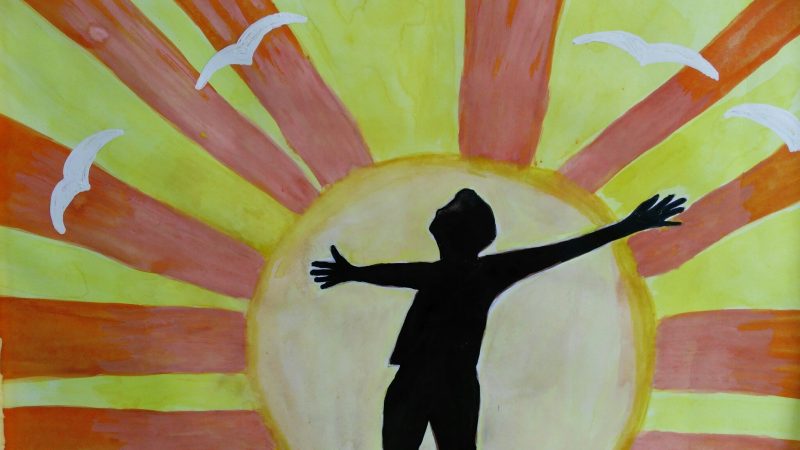The song “May there always be sunshine”, the text of which is translated into many languages, is almost forgotten today. But even 40-50 years ago, she was at everyone’s ears, and every Russian-speaking student knew her by heart.
Material Content:
The text of the song "May there always be sunshine" in different languages
This song sounded on holidays on the radio and always accompanied the school celebrations. First-graders studied it for the holiday of the first bell, and school graduates strode to its peppy rhythms, noting the last school bell in their life.
The simple, sincere lyrics and the equally simple, but catchy melody, for a long time cut into the memory of everyone who at least once heard it.
Thanks to the exceptionally successful, strong text, touching the soul, 2 Let there always be sunshine ”has gained fame far beyond the borders of the Soviet Union.
It was performed on:
- German
- English
- Spanish
- Swedish
- Hebrew
- and even Chinese.
The meaning of the song is so simple, understandable and close to every living person that it is not difficult to translate into any language with almost no distortion. And for many of those who heard or performed this song in childhood, they still have touching memories.
In English
It is not known exactly which year the song was translated, but today the English text is accessible and readily performed by both professional musicians and amateurs.
Let the Sun be forever
The sun in the form of a circle
And the sky is around the Sun
That’s a boy’s drawing.
He drew it on a sheet (of paper)
And wrote on its corner:
"Let the Sun be forever!
Let the sky be forever!
Let my mother be forever!
Let me be evermore! (x2) »
Hey, soldier, be quiet!
Soldier, do you hear
How people are scared by explosions?
Thousands of eyes are looking at the sky,
And lips keep saying stubbornly:
"Let the Sun be forever!
Let the sky be forever!
Let my mother be forever!
Let me be evermore! (x2) »
We will stand for our boys
Against affliction
And war.
“The Sun for life! Happiness for life! ”
That’s what man asked for.
Let the Sun be forever!
Let the sky be forever!
Let my mother be forever!
Let me be evermore! (x2)
Let me be evermore!
German
The song in German sounds even more abruptly, pathos and solemnly than in Russian.
It is safe to say that it fully conveys the idea of peace, freedom and the greatness of the human spirit, embedded in the text. The musical work Immer lebe die Sonne quickly became popular in Germany.
Sonne erhellt
unsere welt
täglich mit goldenen Strahlen.
Schnell bringen wir
sie aufs papier -
Spaß macht es uns, sie zu malen.
Immer lebe die Sonne,
Immer lebe der himmel
Immer lebe die mutti
Und auch ich immerdar!
Garten und beet
kunstvoll entsteht,
Baume mit blättern und blüten
Malen die Welt,
wie’s uns gefällt,
woll’n sie in Frieden behüten.
Immer lebe die Sonne,
Immer lebe der himmel
Immer lebe die mutti
Und auch ich immerdar!
Gegen den Tod,
gegen die Not.
für unser friedliches Leben!
Bei Tag und Nacht haltet ihr Wacht,
die uns das Leben gegeben.
Immer lebe die Sonne,
Immer lebe der himmel
Immer lebe die mutti
Und auch ich immerdar!
In Russian
The text of the song “May there always be sunshine” is not fully known to all, but the refrain is simple and well remembered to everyone who was born and raised in the USSR. Simple and understandable words, devoid of any falsehood, put on the same simple and uncomplicated melody, like a festive march, often sounded on the radio and television in the 60s and 70s. Just a few honest and sincere words, which the child insists on stubbornly believing in the best in spite of everything, easily penetrate the stubborn hearts of adults and cut into memory.
Sunny circle, the sky around
This is a drawing of a boy
He painted on a piece of paper
And signed in the corner
May the sun always be
May there always be heaven
May there always be mom
May I always be
May the sun always be
May there always be heaven
May there always be mom
May I always be
My dear friend, my good friend
People want peace so much
And at thirty five heart again
Never tired of repeating
May the sun always be
May there always be heaven
May there always be mom
May I always be
May the sun always be
May there always be heaven
May there always be mom
May I always be
Hush soldier, hear soldier
People are scared of explosions.
Thousands of eyes staring at the sky
Lips stubbornly repeat
May the sun always be
May there always be heaven
May there always be mom
May I always be
May the sun always be
May there always be heaven
May there always be mom
May I always be
Against trouble, against war
Let's stand for our boys
The sun forever, happiness forever
So commanded man
May the sun always be
May there always be heaven
May there always be mom
May I always be
Who is the author of the famous children's song
The story behind the song is complex and ornate. As for the authorship of the text, it was almost lost. The quatrain, which became the chorus of the song, was composed by a boy named Kostya Barannikov. The boy’s parents explained to the four-year-old the meaning of the word “always”, and the kid creatively processed the information received and came up with imperishable lines. But perhaps they would never have become known to the general public, if not for a happy coincidence. As often happens in the creative sphere, a series of accidents predetermined the further fate of the great creation.
- In 1928, K. Spasskaya, a researcher in child psychology, drew attention to the quatrain written by Kostya Barannikov and published it in the journal "Mother Tongue."
- There he was noticed by the famous children's writer Korney Chukovsky and published it in his book “From Two to Five”.
- The verse published in the book attracted the attention of the artist Nikolai Charukhin. Based on the text read Charuhin created a poster.
A poster with the same name, “May there always be sunshine” caught the eye of the poet L. Oshanin and, inspired by the quatrain, he came up with the lyrics that we now know.
Oshanin came up with the verses of the song, and Barannikov’s quatrain became a refrain. Thus, we can say that the lyrics belong to two authors - Kosta Barannikov and poet L. Oshanin.
In 1962, the text was put to music by Arkady Ostrovsky and performed by Tamara Miansarova in the program "Good morning!"For several decades, the song did not lose popularity in the vast expanses of the USSR and gradually conquered the expanses of near and far abroad.
In 1964, the song was translated into Swedish and released by the group Hootenanny Singers. A composition called Gabrielle quickly became a hit in Sweden, and after that, it was translated into other languages and spread around the globe.
There is still debate about who is the author of the music for the song Gabrielle. Hootenanny Singers were attributed by Stig Rossner and Bengt Thomas, while the music and lyrics were virtually unchanged compared to the Russian-language original. On the other hand, music connoisseurs argue that the music composed by Ostrovsky to this text was not without borrowing. The “Hungarian March” by Franz Liszt, written in the mid-18th century, is surprisingly similar to the melody of the “Solar Circle”, or rather, the latter is similar to it.
However, the creative environment rarely does without easy plagiarism, and in cases where the interpretation is done talentedly, it does not occur to anyone to reproach the authors of the text for being inspired by someone’s achievements. One way or another, fans of Oshanin and Ostrovsky’s creations still have the opportunity to enjoy a wonderful piece of music.

















